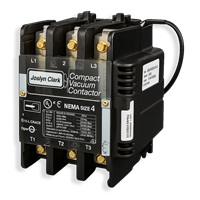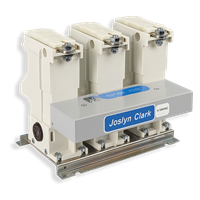Motor starters based on air break technology are often plagued by overheating, noisy operation and frequent failure. Vacuum contactors are a superior alternative to air break for 460 to 7000 V motor starting applications. However, it is important that the vacuum switching device being considered is intended for motor starting duty.
The most difficult task for any switching device is to provide fast interruption of high fault currents with minimum contact wear and burning. Originally introduced a quarter-century ago, the vacuum breaker offers these benefits by sealing the contacts in a vacuum bottle, also referred to as a vacuum interrupter. By excluding air from the contacts, you decrease the chance of arc occurring. Most arcing involves ionization of air. The subsequent heat can maintain current flow for longer than one complete cycle because superheated air remains ionized even after current passes beyond a zero point on the waveform cycle. The only arcing that occurs in vacuum interrupters, consists of vaporized metal from the separating contacts. Arc extinction and complete current interruption occur within a fraction of a cycle.
For that reason, vacuum based devices are designed without the cumbersome, energy-consuming and unreliable features of air circuit breakers. For instance, vacuum based devices do not require the long contact travel, bulky arc chutes, and large magnetic blowout coils that air break devices use to stretch and cool a heavy arc in air. Lower operating forces allow simpler contact opening and closing mechanisms. Also, the absence of intense arcing greatly prolongs the life of the contacts themselves.
One operating problem arose due to the fast interrupting action of contacts in vacuum. A sudden rise in voltage occurs whenever current ceases to flow in any circuit containing inductance, such as a motor starter. The more abrupt the current interruption, the higher the transient voltage spike will be. Sooner or later, this condition will break down the insulation in a motor's winding. An air-break contact slowly interrupts this current. However, the current is "chopped" to zero almost instantly in a vacuum based device (See Fig. 1). A dangerously high transient voltage appears each time the breaker opens. Learn more about switching transients here.

Fig. 1 demonstrates the significance of current chop. Vacuum contacts tend to cut off current flow instantly (point A); the extremely high rate of change in current produces high transient voltage. An airbreak current-limiting breaker or fuse allows more gradual drop in current (point B); other interrupting devices don’t stop current flow until the first current-zero (point C). For motor starter use, vacuum contactors must be especially designed to act more like the point B interruption.
Some breaker manufacturers and industry standards, such as IEEE 141, recommended surge protective devices on motor circuits fed through vacuum breakers. Such protection was either built into switchgear cubicles or supplied with the motors. However, changes in vacuum contractor technology no longer make this a common practice.
There can be drawbacks to vacuum contactors in motor starter applications. Its contacts, which are designed to infrequently interrupt high current, are not appropriate for the day-in, day-out switching of much lower motor starting currents. As in the combination starter, long familiar to industrial motor users, fault protection is better provided by an upstream fused disconnect switch or breaker while the on-off motor switching is handled by a smaller, simpler “contactor.”
However, conventional contactors tend to wear out through frequent usage, and require energy-consuming operating coils. The vacuum contactor was developed to reduce those disadvantages. Although it was first introduced for medium voltage motor control (2300 to 6900 V), several makes of low voltage (600 to 1500 V) units are now available for 460 V motor control. These are often used at 900 to 1000 V for mine motor service, or for oilfield submersible pumps.
Vacuum Motor Starters
Vacuum motor starters feature two major design differences from the vacuum circuit breaker. First, operation is much more frequent, although at lower current. This reduces both unit size and required operating force. Typical operating life is 1 million operations at rated current.
Second, contact design is altered by changing the contact alloy to prolong the arc when the contacts part to reduce the “current chop” effect, almost eliminating the transient voltage spike. The change of alloy could be unacceptable in a vacuum breaker because it would prolong the flow of fault current (See Fig. 3).

Fig. 3 The cross-section of “vacuum bottle” (one pole of a vacuum contactor) shows that separation of open contacts may be only 1/16 to 1/4 inch in a motor starter; 5/8 to 3/4 inch for a circuit breaker.
An internal compression spring produces “overtravel” for the operating mechanism, to minimize “bounce” when contacts close.
Even with these design changes, vacuum starters still provide faster current interruption, with much less arcing, than an air-break starter. A free-standing vacuum starter will only occupy 20% to 35% of the space that an air-break units would.
Other advantages to vacuum contacts include:
- Resistance to contamination; no arc chutes to clean.
- Suitably to frequent operation—up to 20 times a minute.
- Less noise, because of reduced mechanism force and travel, and lower holding coil power.
- Reduced contact maintenance. In a typical severe application, vacuum starter contacts lasted more than a year and a half; air-break contacts needed replacement twice a month.
Due to low operating power and the absence of heavy-duty continuously energized blowout coils, a vacuum starter can be an impressive energy saver. For a 100 A rating, in a typical 400 hp motor circuit, an air-break starter may use 620 W of power; the corresponding vacuum unit only 180 W. in one 1500 hp, 2300 V motor circuit, actual air-break contactor losses were 1057 W, vs. only 400 W for the vacuum device. One manufacturer cites these loss figures for a vacuum starter alternative to an air-break unit requiring 1000 W: Assuming full load on the circuit three-fourths of the time, the vacuum unit would save about $230 annually at a national average cost of $0.07 per kWh.
Replacing Air Break Equipment
The benefits of vacuum contactor operation can support cost effective replacement of older air-break equipment. In a large chemical plant, using conventional medium voltage controllers (See Fig. 7), a major starter failure occurred almost every year. Contact assemblies were jolted by severe vibration for cyclic loading of some 1500 hp motors. As line current varied over a 3 to 1 range every 1 ½ sec, contact movement reached 4 ½ mils at a frequency of 10 cycles per sec. Added to this was high cubicle temperature caused by heat from starter blowout coils. Adding cooling fans to the cubicle did not alleviate this condition. Breakdown of one unit often damaged another on the adjoining cubicle (See Fig 8). Main contacts needed frequent replacement.
|
Contacts |
6 W |
|
Fuses |
120 W |
|
Operating coils |
240 W |
|
Relay/CTs |
120 W |
|
Connecting cable |
15 W |
|
Total |
501 W |
Replacing these starters with vacuum devices lowered cubicle temperature 30°C, cut vibration to one-fourth its former value, and eliminated starter failure for at least 4 years.
Low voltage retrofits can be equally effective. According to an early report, one set of starters for 125 to 200 hp motors was installed in an air-conditioned room. Motor starting frequency ranged from one per hour to one per week. Starter contact life was inadequate. Rapid wear, with occasional welding; required contact replacement every 8 months. A larger size air-break starter would not fit in existing cubicles.
A cost study indicated that replacement of each starter with a vacuum unit would be paid off in contact replacement savings alone within 15 months. The replacement was then complete. From then until the date of the report, no starter troubles or motor winding failures had occurred.
Other applications have highlighted the long operating life to be expected of vacuum starters.
- A metal shear, operated every 8 sec, caused air-break contacts to wear out in 2 months; the associated arc chutes needed replacement after 1 ½ years, still had 20% of its useful life remaining.
- In a Gulf Coast chemical plant, a vacuum contactor was still in good working order after 3 million operations in 3 years.
Freedom from dirt and corrosion helps lengthen contact life. In one mining application, coal dust was a problem for air-break equipment. But a vacuum contactor needed no maintenance. Even annual inspections were eventually discontinued.
Application Considerations
Gradual contact wear does occur in a vacuum starter, of course, because the small arcs at each operation vaporize some contact material. Since the contacts themselves are invisible within the individual phase chamber or bottle, some external means of checking wear must be provided—usually by the position of the moveable contact arm or rod projecting from each bottle, when the contacts are closed. A feeler gauge measurement of arm travel reveals the slight change in arm position caused by wear. Typical contactor maintenance instructions prescribe that check at each half millionth operations.
Another cause for concern with any vacuum device is bottle leakage, with subsequent loss of vacuum. Destructive arcing could result in the contacts then opened under load. However, loss of vacuum is more than one of the three-phase bottles is highly unlikely. And if air is present in only one, when the contactor is closed, safe circuit interruption can still be carried out by the other two.
The importance of atmospheric pressure is the basis for the altitude rating of a vacuum contactor. At too high an elevation, air pressure is too low for proper operation. But standard contactors are typically usable up to 10,000 ft. Learn more about how to specify a vacuum contact for high altitude here.
Loss of vacuum can be checked by applying a 1 min overvoltage test across the open contacts of a de-energized starter. The small gap between contacts will break down if air is present. Ask the contactor manufacture for the correct test voltage.
Although the main contacts themselves are remarkably maintenance-free, remember that the complete starter must still include an operating coil, often with an associated rectifier, plus rods, springs, pivots, and all the other mechanical components used with any starter. Those remain exposed to moisture and dirt. Fasteners may loosen, or linkages bind. And auxiliary contacts for low voltage control circuits are also vulnerable.
With those limitations in mind, the user of vacuum motor starters can take full advantage of the benefits of such equipment—especially in hot, dirty, crowded surroundings, with frequent operation and fluctuating load.
How to specify vacuum contactors for high altitude environments
What are switching transients and how to minimize them with vacuum contactors
CV Series Compact Vacuum Contactor
Joslyn Clark’s Compact CV Series Vacuum Contactors and Starters are ideal for tough industrial applications. The compact design provides flexibility for retrofitting air break contactors, thus enabling an existing application to continue with maintenance cost and down time eliminated. Voltage raging from 600V to 1500KV and current ratings up to 600A are available.Learn more »
MVC Series Medium Voltage Vacuum Contactor
The Joslyn Clark USAVAC medium voltage vacuum contactors are 3-phase motor contactors built for control and protection in medium voltage applications ranging from 2300V to 7200V. Current ratings of 200-1200 ampere, and motor ratings up to 7000 HP at 6600V are available.Learn more »




